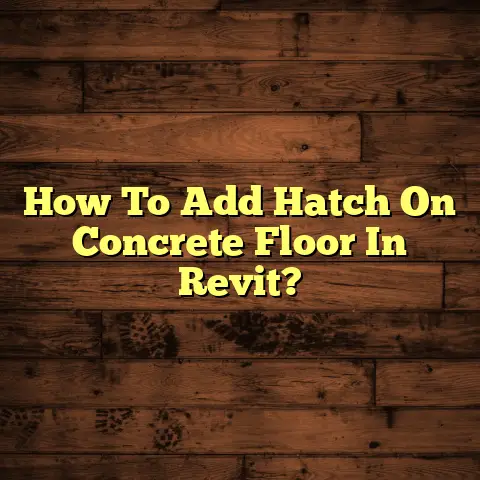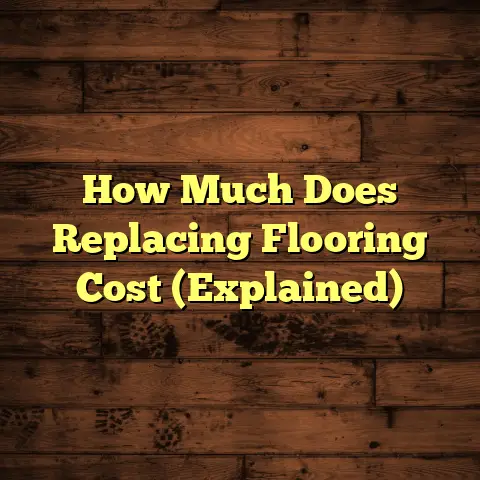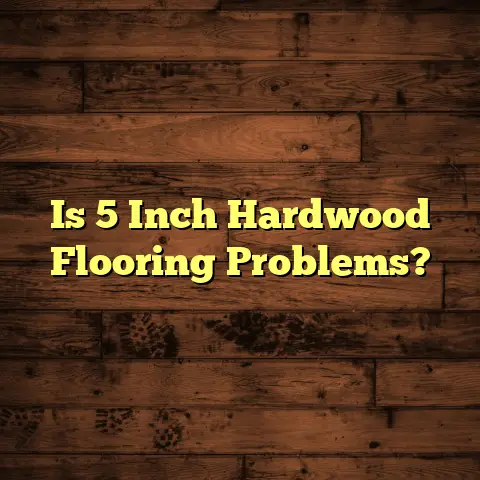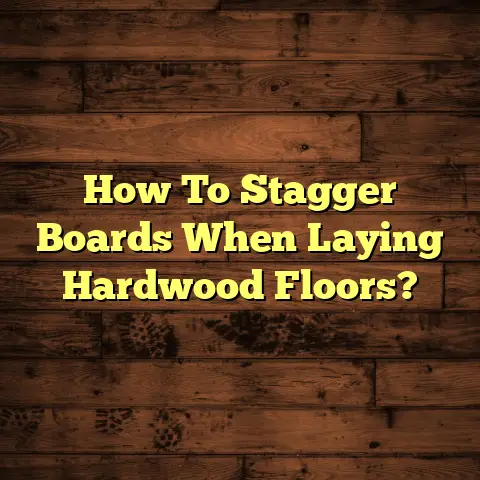Removing Old Floor Adhesives? (2 Pro Removal Secrets!)
I’m thrilled you’re here, ready to tackle that old flooring adhesive.
Let’s be honest, ripping up old floors is rarely fun, but it’s so satisfying when you finally get to install something fresh and new.
And speaking of fresh and new, have you noticed how everyone’s going crazy for eco-friendly flooring options these days?
From bamboo and cork to recycled materials, homeowners are prioritizing sustainability and healthier indoor environments.
I’ve seen a huge shift in the last few years. People aren’t just thinking about the look of their floors, but also about the impact they have.
That’s why prepping your subfloor correctly is more important than ever.
You want a clean slate, free from old adhesives that could interfere with the new flooring’s performance and potentially release harmful VOCs.
But here’s the thing: removing old floor adhesive can be a real pain.
I’ve seen so many homeowners struggle with this, spending hours scraping away at stubborn residue.
It doesn’t have to be that way!
That’s why I’m sharing my two pro removal secrets.
These tips will help you get the job done faster, easier, and with less frustration.
Trust me, I’ve been there, done that, and learned a few tricks along the way.
Ready to dive in? Let’s get that subfloor ready for its amazing new makeover!
Section 1: Understanding Floor Adhesives
So, before we start swinging hammers and wielding scrapers, let’s talk about what we’re actually dealing with: floor adhesives.
Think of them as the glue that holds your flooring dreams together (or, in this case, holds your old flooring dreams together).
But not all adhesives are created equal.
Types of Floor Adhesives
There’s a whole world of adhesives out there, each with its own personality and quirks. Knowing what type you’re facing is crucial for choosing the right removal method. Here’s a rundown of the most common culprits:
-
Water-Based Adhesives: These are generally the most eco-friendly and easiest to work with. They’re commonly used for vinyl, carpet, and some types of tile. The good news is that they tend to soften with water and heat. The bad news? They can still leave behind a sticky residue.
-
Solvent-Based Adhesives: These are the heavy-duty adhesives, often used for tougher flooring materials like hardwood and some types of resilient flooring. They’re known for their strong bond and resistance to moisture, which also makes them a beast to remove. Think strong fumes and stubborn residue.
-
Pressure-Sensitive Adhesives (PSAs): These are often found under carpet tiles and some types of vinyl. They’re designed to stick with pressure, which means they can be surprisingly tenacious. They often leave behind a gummy, almost impossible- to-remove film.
Think of it this way: water-based adhesives are like that friendly coworker who’s always willing to help. Solvent-based adhesives are like that grumpy uncle who refuses to budge. And PSAs? They’re like that clingy ex you just can’t shake.
Why Removal is Necessary
“Why can’t I just install the new floor over the old adhesive?” I hear you ask.
Great question! Here’s the deal: leaving old adhesive in place can cause a whole host of problems:
-
Poor Adhesion: The new flooring might not bond properly to the subfloor if there’s old adhesive in the way. This can lead to loose tiles, squeaky floors, and a shorter lifespan for your new investment. I’ve seen floors fail miserably because of this.
-
Mold Growth: Old adhesive can trap moisture, creating a breeding ground for mold and mildew. Nobody wants that! Plus, mold can cause serious health problems.
-
Indoor Air Quality: Some old adhesives can release volatile organic compounds (VOCs) into the air, which can cause irritation and other health issues. Especially important if you have kids, pets, or allergies.
-
Uneven Surface: Even a thin layer of old adhesive can create an uneven surface, which can telegraph through to the new flooring. This is especially noticeable with thin materials like vinyl or laminate.
-
Warranty Issues: Many flooring manufacturers require a clean, properly prepared subfloor for their warranties to be valid. Skipping the adhesive removal step could void your warranty.
Trust me, taking the time to remove the old adhesive properly is worth it in the long run. It’s like building a house on a solid foundation. You wouldn’t skip that step, would you?
Common Challenges
Okay, so we know why we need to remove the adhesive. But what makes it so darn difficult? Here are some of the most common challenges I’ve encountered:
-
Stubborn Residue: Some adhesives are just incredibly difficult to remove, leaving behind a thin, tenacious layer that seems impossible to get rid of. This is especially true with solvent- based adhesives and PSAs.
-
Damage to the Subfloor: Aggressive scraping or using the wrong tools can damage the subfloor, requiring costly repairs. I’ve seen people gouge their subfloors so badly that they had to replace entire sections.
-
Time-Consuming Task: Let’s face it, removing old adhesive is a slow and tedious process. It can take hours, or even days, to complete a large area. Prepare for some elbow grease!
-
Fumes and Dust: Some adhesive removal methods can create unpleasant fumes or generate a lot of dust, requiring proper ventilation and safety precautions. Think respirators and open windows.
-
Identifying the Adhesive Type: As we discussed earlier, knowing what type of adhesive you’re dealing with is crucial for choosing the right removal method. But sometimes it’s hard to tell!
Don’t worry, though. With the right tools and techniques, you can overcome these challenges and get that subfloor sparkling clean. That’s where my pro secrets come in!
Section 2: Pro Removal Secret #1 -The Right Tools
Alright, let’s talk tools!
Having the right tools for the job is absolutely essential. It’s like trying to bake a cake without a mixing bowl – you might be able to do it, but it’s going to be a lot harder and messier.
I’ve seen homeowners struggle needlessly because they were using the wrong tools, or using them incorrectly.
Don’t be that person!
Essential Tools for Adhesive Removal
Here’s my list of must-have tools for effective adhesive removal:
-
Floor Scraper: This is your primary weapon in the battle against old adhesive. Look for one with a long handle for better leverage and a sturdy blade that won’t bend or break easily. I prefer scrapers with replaceable blades, so you can always have a sharp edge.
-
Putty Knife/Small Scraper: These are great for getting into corners and tight spaces where the floor scraper can’t reach. A flexible blade is helpful for conforming to uneven surfaces.
-
Heat Gun: This tool is your secret weapon for softening stubborn adhesives. It uses hot air to loosen the bond, making it easier to scrape away. Be careful not to overheat the adhesive, as this can cause it to become even stickier.
-
Chemical Adhesive Remover: These are specially formulated solvents that dissolve or soften adhesives. They come in various forms, including liquids, gels, and sprays. Be sure to choose a remover that’s compatible with your subfloor material and the type of adhesive you’re dealing with. Always follow the manufacturer’s instructions carefully and wear appropriate safety gear.
-
Oscillating Multi-Tool: This versatile tool can be a lifesaver for removing adhesive in hard-to-reach areas or for sanding down stubborn residue. Use a scraper blade or a sanding pad, depending on the situation.
-
Shop Vacuum: Cleaning up the debris is just as important as removing the adhesive. A shop vacuum with a HEPA filter will help you keep the work area clean and dust-free.
-
Safety Glasses: Protect your eyes from flying debris. Trust me, you don’t want to get adhesive in your eyes.
-
Gloves: Protect your hands from chemicals and sharp edges.
-
Respirator: If you’re using chemical removers or generating a lot of dust, wear a respirator to protect your lungs.
-
Knee Pads: You’ll be spending a lot of time on your knees, so protect them with some comfortable knee pads. Your body will thank you later.
Tool Usage Techniques
Okay, so you’ve got your tools. Now, how do you use them effectively? Here are some tips and tricks I’ve learned over the years:
-
Floor Scraper: Hold the scraper at a low angle and use a steady, even pressure to scrape away the adhesive. Avoid using too much force, as this can damage the subfloor. Work in small sections and overlap your strokes. Keep the blade sharp for best results.
-
Heat Gun: Hold the heat gun a few inches away from the adhesive and move it slowly back and forth. Don’t hold it in one spot for too long, as this can scorch the adhesive or damage the subfloor. Test the adhesive periodically to see if it’s softening.
-
Chemical Adhesive Remover: Apply the remover according to the manufacturer’s instructions. Some removers require you to let them sit for a certain amount of time before scraping. Be sure to provide adequate ventilation and wear appropriate safety gear.
-
Oscillating Multi-Tool: Use a low speed to avoid damaging the subfloor. Experiment with different blades and sanding pads to find the best option for your specific situation.
-
General Tips: Always work in a well-ventilated area. Take breaks when you need them. Don’t be afraid to experiment with different techniques to find what works best for you.
Which tools are best for which adhesives? That’s a great question! Here’s a quick guide:
-
Water-Based Adhesives: Floor scraper, putty knife, heat gun (optional), water.
-
Solvent-Based Adhesives: Floor scraper, chemical adhesive remover, heat gun (optional), oscillating multi-tool.
-
Pressure-Sensitive Adhesives: Floor scraper, chemical adhesive remover (specifically designed for PSAs), oscillating multi-tool.
And what about different subfloors?
-
Wood Subfloors: Be extra careful not to damage the wood. Avoid using excessive force or harsh chemicals.
-
Concrete Subfloors: These are generally more durable, but you still want to avoid gouging or cracking the surface.
-
Tile Subfloors: Removing adhesive from tile can be tricky, as you don’t want to damage the underlying tile. Use a gentle approach and avoid using abrasive tools.
Cost-Effective Options
I know what you’re thinking: “All these tools sound expensive!” Don’t worry, you don’t have to break the bank to get the job done. Here are some cost-effective alternatives:
-
Rent Tools: Renting a floor scraper or an oscillating multi-tool can be much cheaper than buying one, especially if you only need it for a single project.
-
DIY Scraper: You can make your own scraper by attaching a sturdy blade to a wooden handle.
-
Homemade Adhesive Remover: Some people swear by homemade adhesive removers made from vinegar, baking soda, or citrus solvents. I haven’t personally tried these, but they might be worth a shot if you’re on a tight budget. Always test them in an inconspicuous area first.
-
Borrow Tools: Ask your friends, family, or neighbors if they have any of the tools you need. You might be surprised at what people are willing to lend.
The bottom line is that having the right tools will make the job much easier and more efficient. Don’t skimp on the essentials, but don’t be afraid to get creative and find cost-effective solutions.
Section 3: Pro Removal Secret #2 -Proven Techniques
Okay, now that we’ve got our tools lined up, let’s talk technique. This is where the real magic happens!
Knowing the right techniques can save you time, effort, and a whole lot of frustration.
I’m going to share my go-to methods for tackling even the most stubborn adhesives.
Heat Application
Heat is your friend when it comes to softening up stubborn adhesives. It works by breaking down the bond between the adhesive and the subfloor, making it easier to scrape away.
Here’s how to use heat effectively:
-
Equipment Needed: Heat gun, floor scraper, safety glasses, gloves.
-
Safety First: Always wear safety glasses and gloves when using a heat gun. Be careful not to overheat the adhesive or the subfloor, as this can cause damage. Work in a well-ventilated area.
-
Application Method: Hold the heat gun a few inches away from the adhesive and move it slowly back and forth. Don’t hold it in one spot for too long. Test the adhesive periodically to see if it’s softening. Once the adhesive is softened, use a floor scraper to scrape it away.
-
Ideal Temperature Ranges: The ideal temperature range for softening adhesive is typically between 150°F and 250°F (65°C and 120°C). Start with a lower temperature and gradually increase it until the adhesive starts to soften.
Different adhesive types react differently to heat. Water-based adhesives tend to soften quickly, while solvent-based adhesives may require more heat and time. PSAs can become gummy and difficult to remove if overheated.
I’ve found that using a combination of heat and scraping is often the most effective approach. Apply heat to a small section of adhesive, scrape it away, and then move on to the next section.
Chemical Adhesive Removers
Chemical adhesive removers are another powerful tool in the fight against old adhesive. They work by dissolving or softening the adhesive, making it easier to scrape away.
Here’s what you need to know about chemical adhesive removers:
-
Types of Removers: There are many different types of chemical adhesive removers available, each with its own strengths and weaknesses. Some are designed for specific types of adhesives, while others are more general-purpose. Read the product label carefully to make sure it’s compatible with your subfloor material and the type of adhesive you’re dealing with.
-
Application Methods: Chemical adhesive removers can be applied in various ways, including spraying, brushing, or pouring. Follow the manufacturer’s instructions carefully. Some removers require you to let them sit for a certain amount of time before scraping.
-
Safety Measures: Always wear appropriate safety gear when using chemical adhesive removers, including safety glasses, gloves, and a respirator. Work in a well-ventilated area. Avoid contact with skin and eyes. Keep out of reach of children and pets.
What are the pros and cons of chemical removal versus mechanical methods?
Chemical Removal:
-
Pros: Can be very effective for removing stubborn adhesives. May require less physical effort than mechanical methods. Can be used in hard-to-reach areas.
-
Cons: Can be expensive. May contain harsh chemicals. Requires careful safety precautions. Can damage certain subfloor materials.
Mechanical Removal:
-
Pros: Generally safer than chemical removal. Less expensive. Doesn’t require special equipment.
-
Cons: Can be more time-consuming and labor-intensive. May not be as effective for removing stubborn adhesives. Can damage the subfloor if not done carefully.
I usually recommend starting with a mechanical method, such as scraping or using a heat gun. If that doesn’t work, then you can try a chemical adhesive remover.
Step-by-Step Guides
Okay, let’s get down to the nitty-gritty. Here are detailed, step-by-step guides for each method:
Heat Application:
-
Preparation: Clear the area of any furniture or debris. Protect the surrounding surfaces with drop cloths. Put on your safety glasses and gloves.
-
Execution: Hold the heat gun a few inches away from the adhesive and move it slowly back and forth. Test the adhesive periodically to see if it’s softening. Once the adhesive is softened, use a floor scraper to scrape it away. Work in small sections and overlap your strokes.
-
Post-Removal Cleaning: Use a shop vacuum to clean up any debris. Wipe down the subfloor with a damp cloth to remove any remaining residue.
Chemical Adhesive Remover:
-
Preparation: Clear the area of any furniture or debris. Protect the surrounding surfaces with drop cloths. Put on your safety glasses, gloves, and respirator.
-
Execution: Apply the remover according to the manufacturer’s instructions. Let it sit for the recommended amount of time. Use a floor scraper to scrape away the softened adhesive. Work in small sections and overlap your strokes.
-
Post-Removal Cleaning: Use a shop vacuum to clean up any debris. Wipe down the subfloor with a damp cloth to remove any remaining residue. You may need to use a special cleaner to neutralize the chemical remover.
Remember, safety is always the top priority. Follow the manufacturer’s instructions carefully and wear appropriate safety gear.
Section 4: Final Touches and Preparation for New Flooring
You’ve done it! You’ve successfully removed the old adhesive. But the job’s not quite done yet.
Now it’s time to focus on the final touches and prepare the subfloor for its new flooring.
This is a crucial step, as it can affect the performance and longevity of your new floor.
Cleaning the Subfloor
A clean subfloor is essential for proper adhesion of the new flooring. Any remaining residue, dust, or debris can interfere with the bond and lead to problems down the road.
Here are some effective cleaning methods:
-
Vacuuming: Use a shop vacuum with a HEPA filter to remove any loose debris.
-
Scrubbing: Use a scrub brush and a mild detergent to scrub the subfloor. Rinse thoroughly with clean water.
-
Solvent Cleaning: For stubborn residue, you may need to use a solvent cleaner. Be sure to choose a cleaner that’s compatible with your subfloor material. Follow the manufacturer’s instructions carefully and wear appropriate safety gear.
-
Sanding: For rough or uneven surfaces, you may need to sand the subfloor. Use a sanding block or an orbital sander with a fine-grit sandpaper.
I recommend vacuuming the subfloor thoroughly after each cleaning step.
Assessing Subfloor Condition
Once the subfloor is clean, it’s time to inspect it for any damage or imperfections.
Look for:
-
Cracks: Small cracks can be filled with a crack filler. Larger cracks may require more extensive repairs.
-
Holes: Holes can be filled with a patching compound.
-
Unevenness: Unevenness can be corrected with a self-leveling compound.
-
Moisture: Moisture can cause problems with the new flooring. Use a moisture meter to check the moisture level of the subfloor. If the moisture level is too high, you’ll need to take steps to dry it out before installing the new flooring.
-
Rot: If you find any rot, you’ll need to remove the affected area and replace it with new material.
Addressing these issues now will ensure a smooth, stable surface for your new flooring.
Preparing for New Flooring Installation
Now that the subfloor is clean and in good condition, it’s time to prepare it for the new flooring installation.
Here are the steps you need to take:
-
Leveling: If the subfloor is uneven, you’ll need to level it with a self- leveling compound. Follow the manufacturer’s instructions carefully.
-
Moisture Testing: Use a moisture meter to check the moisture level of the subfloor. The moisture level should be within the acceptable range for the new flooring.
-
Underlayment: Install an underlayment if required by the flooring manufacturer. Underlayment can provide cushioning, sound insulation, and moisture protection.
-
Acclimation: Allow the new flooring to acclimate to the room’s temperature and humidity for the recommended amount of time. This will help prevent warping or buckling after installation.
-
Layout: Plan the layout of the new flooring. This will help you avoid awkward cuts and ensure a professional- looking finish.
By following these steps, you’ll create a solid foundation for your new flooring and ensure a beautiful, long-lasting result.
Conclusion
Congratulations! You’ve reached the end of our journey through the world of old adhesive removal.
You now have the pro secrets you need to tackle this challenging task with confidence.
Remember, the key to success is using the right tools and techniques. Choose the tools that are best suited for your specific situation and follow the instructions carefully.
Don’t be afraid to experiment and find what works best for you. And always prioritize safety.
Removing old adhesive can be a time-consuming and labor-intensive process, but it’s worth it in the long run. A clean, properly prepared subfloor will ensure that your new flooring looks great and lasts for years to come.
So, go ahead and take on the challenge. I know you can do it!
Call to Action
Now it’s your turn! Have you ever removed old floor adhesive? What challenges did you face? What tips would you share with other DIY enthusiasts?
Share your experiences or ask questions in the comments section below. Let’s create a community of DIYers who are eager to tackle their flooring projects!
And don’t forget to share this article with your friends who are planning a flooring renovation. They’ll thank you for it!





